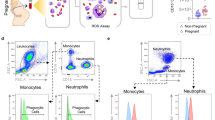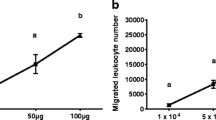Abstract
Objective
The cause of elevated blood leukocyte count in pregnancy is unknown. We hypothesized that priming of peripheral polymorphonuclear leukocytes (PMNL) caused this elevation.
Methods
Eleven women in the first trimester of pregnancy were included in this prospective study. Peripheral venous blood was drawn twice from each woman, before and after a medical abortion (pregnant and nonpregnant, respectively). Complete blood cell count, plasma alkaline phosphatase (ALP), and rate of superoxide release from separated phobrol 12-myristate-13-acetate (PMA)-stimulated PMNL were determined.
Results
The PMNL count in early pregnancy was significantly higher, with a significant increase in the PMNL rate of superoxide release compared to the nonpregnant state. A linear correlation between the rates of superoxide release and PMNL counts before and during pregnancy was found. ALP levels were significantly elevated in early pregnancy.
Conclusion
The increased PMNL count is probably a compensatory response to PMNL priming. The increased rate of superoxide release from primed PMNL may contribute to oxidative stress in early pregnancy.
Similar content being viewed by others
References
Gutteridge JM. Free radicals in disease processes: A compilation of cause and consequence. Free Radic Res Commun 1993;19:141–58.
Hubel CA, Roberts JM, Taylor RN, et al. Lipid peroxidation in pregnancy: New perspectives on preeclampsia. Am J Obstet Gynecol 1989;161:1025–34.
Wang YP, Walsh SW, Guo JD, Zhang JY. Maternal levels of prostacyclin, thromboxane, vitamin E, and lipid peroxides throughout normal pregnancy. Am J Obstet Gynecol 1991;165:1690–4.
Davidge ST, Hubel CA, Brayden RD, Capeless EC, McLaughlin MK. Sera antioxidant activity in uncomplicated and preeclamptic pregnancies. Obstet Gynecol 1992;79:897–901.
Knapen MF, Mulder TP, Van Rooij IA, Peters WH, Steegers EA. Low whole blood glutathione levels in pregnancies compli cated by preeclampsia or the hemolysis, elevated liver enzymes, low platelets syndrome. Obstet Gynecol 1998;92:1012–5.
Tabacova S, Little KB, Balabaeva L, Pavlova S, Petrov I. Complications of pregnancy in relation to maternal lipid peroxides, glutathione, and exposure to metals. Reprod Toxicol 1994;8:217–24.
Ornoy A, Kimyagarov D, Yaffee P, et al. Role of reactive oxygen species in diabetes-induced embryotoxicity: Studies on pre-implantation mouse embryos cultured in serum from diabetic pregnant women. Isr J Med Sci 1996;32:1066–73.
Fait V, Sela S, Ophir E, et al. Hyperemesis gravidarum is associated with oxidative stress. Am J Perinatol 2002;19:93–8.
Cunningham FG, Gant NF, Leveno KJ, et al. Maternal adaptation to pregnancy. In: Cunningham FG, Gant NF, Leveno KJ, et al, eds. Williams obstetrics. 21st ed. New York: McGraw-Hill, 2001:177–81.
Kristal B, Shurtz-Swirski R, Chezar J, et al. Participation of peripheral polymorphonuclear leukocytes in the oxidative stress and inflammation in patients with essential hypertension. Am J Hypertens 1998;11:921–8.
Shurtz-Swirski R, Sela S, Herskovits AT, et al. Involvement of peripheral polymorphonuclear leukocytes in oxidative stress and inflammation in type 2 diabetic patients. Diabetes Care 2001;24:104–10.
McCall CE, DeChatelet LR, Cooper MR, Shannon C. Human toxic neutrophils. 3. Metabolic characteristics. J Infect Dis 1973;127:26–33.
Guthrie LA, McPhail LC, Henson PM, Johnston RB Jr. Priming of neutrophils for enhanced release of oxygen metabolites by bacterial lipopolysaccharide. Evidence for increased activity of the superox-ide-producing enzyme. J Exp Med 1984;160:1656–71.
Botha AJ, Moore FA, Moore EE, et al. Postinjury neutrophil priming and activation states: therapeutic challenges. Shock 1995;3:157–66.
Klebanoff SJ, Clark PA. Iodination by human polymorphonuclear leukocytes: A re-evaluation. J Lab Clin Med 1977;89:675–86.
Kristal B, Shurtz-Swirski R, Shasha SM, et al. Interaction between erythropoietin and peripheral polymorphonuclear leukocytes in hemodialysis patients. Nephron 1999;81:406–13.
Babior BM, Kipnes RS, Curnutte JT. Biological defense mechanisms. The production by leukocytes of superoxide, a potential bactericidal agent. J Clin Invest 1973;52:741–4.
Shibuya T, Izuchi K, Kuroiwa A, Okabe N, Shirakawa K. Study on nonspecific immunity in pregnant women: Increased chemi-luminescence response of peripheral blood phagocytes. Am J Reprod Immunol Microbiol 1987;15:19–23.
Onwukeme KE, Uguru VE. Haematological values in pregnancy in Jos. West Afr J Med 1990;9:70–5.
Umesaki N, Fukumasu H, Miyama M, Kawabata M, Ogita S. Plasma granulocyte colony stimulating factor concentrations in pregnant women. Gynecol Obstet Invest 1995;40:5–7.
Circota R, Balloch A, Metz J, Layton JE, Lieschke GJ. Physiological neutrophilia is not associated with a rise in plasma granulocyte colony-stimulating factor (G-CSF) [Letter]. Am J Hematol 1995;48:288–95.
Sacks GP, Studena K, Sargent K, Redman CW. Normal pregnancy and preeclampsia both produce inflammatory changes in peripheral blood leukocytes akin to those of sepsis. Am J Obstet Gynecol 1998;179:80–6.
von Dadelszen P, Watson RW, Noorwali F, et al. Maternal neutrophil apoptosis in normal pregnancy, preeclampsia, and normotensive intrauterine growth restriction. Am J Obstet Gynecol 1999;181:408–14.
Cunningham FG, Gant NF, Leveno KJ, et al. Maternal adaptation to pregnancy. In: Cunningham FG, Gant NF, Leveno KJ, et al, eds. Williams obstetrics. 21st ed. New York: McGraw-Hill, 2001:189–90.
Okamoto T, Seo H, Mano H, et al. Expression of human placenta alkaline phosphatase in placenta during pregnancy. Placenta 1990;11:319–27.
Sela S, Shurtz-Swirski R, Awad J, et al. The involvement of peripheral polymorphonuclear leukocytes in the oxidative stress and inflammation among cigarette smokers. Isr Med Assoc J 2002;4:1015–9.
Author information
Authors and Affiliations
Corresponding author
Rights and permissions
About this article
Cite this article
Fait, V., Sela, S., Ophir, E. et al. Peripheral Polymorphonuclear Leukocyte Priming Contributes to Oxidative Stress in Early Pregnancy. Reprod. Sci. 12, 46–49 (2005). https://doi.org/10.1016/j.jsgi.2004.08.005
Published:
Issue Date:
DOI: https://doi.org/10.1016/j.jsgi.2004.08.005




